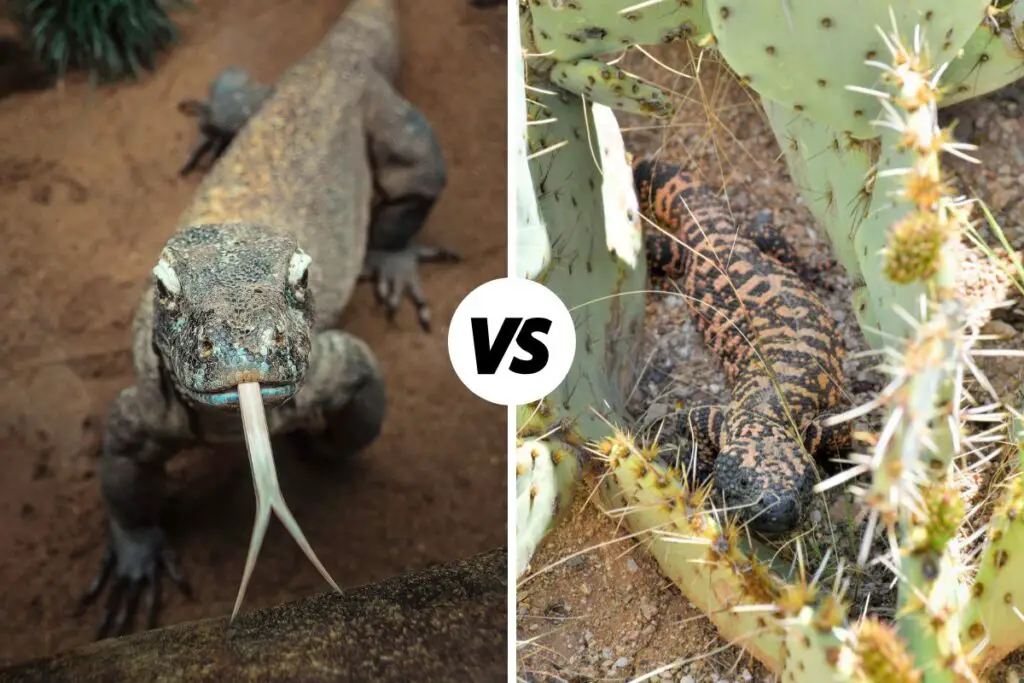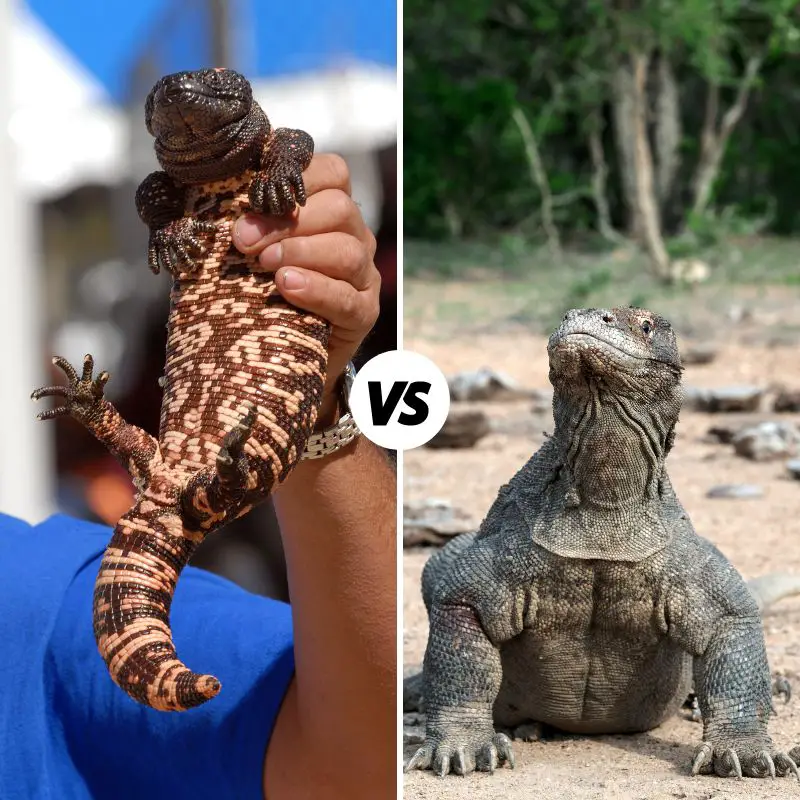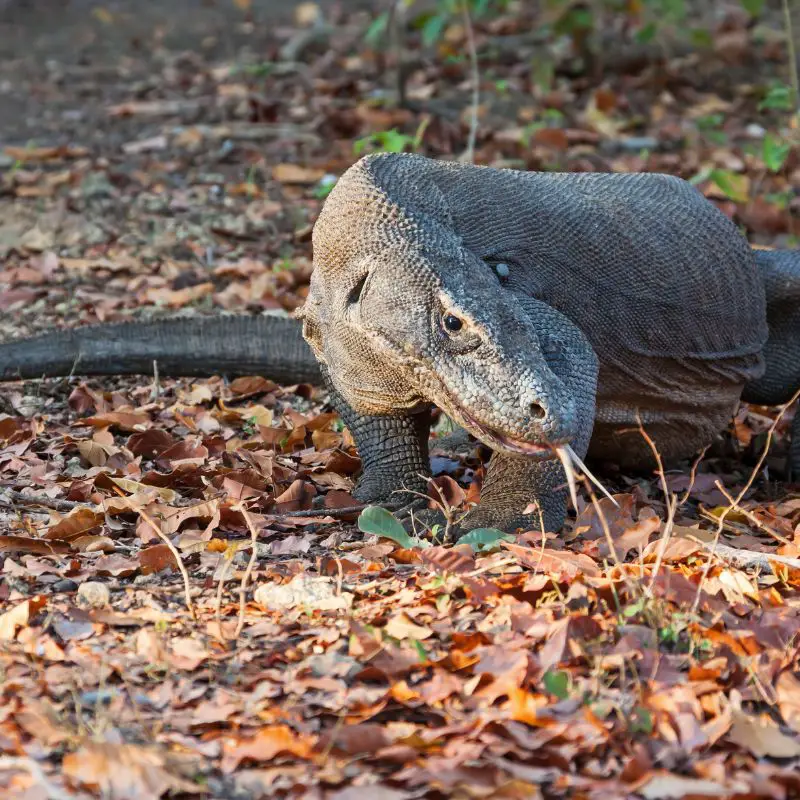Few creatures on Earth are as awe-inspiring and fierce as a Komodo Dragon or Gila Monster. Though both belong to the monitor lizard family (Varanidae), these two lizards differ in remarkable ways that make them easily distinguishable from one another.
The primary differences between Komodo Dragons and Gila Monsters are their diets, lifespan, and size. However, their tolerance for humans and their endangered status vary too.
This article will look at the main differences between these large reptiles and how to tell them apart easily.

6 Differences Between Komodo Dragons And Gila Monsters
Here are six detailed facts about these two lizards and their comparison.
1. Physical Features
The Komodo dragons are not called the largest reptile on Earth for nothing. These lizards can grow up to 10 feet for males and 8 feet for females. They weigh around 70 kg (150 lbs).
Generally, males weigh more than females. These lizards are visually intimidating and stand out from a distance, having a gray and yellowish tinge stretching along their scales and a long double-edged tongue.
Gila monsters can grow up to 2 feet long (0.60 meters) and weigh around 2 kg (4.4 lbs). There are no substantial differences in their weights and sizes when comparing the males and females of this lizard species.
That makes them much smaller and weaker than Komodo dragons. Gila monsters stand out due to their highly contrasting color of black paired with either orange or pink.
Fun Fact: Komodo dragons often have tails as long as their bodies. That means half of their length counts as their tail.

2. Habitats and Nativity
Komodo dragons inhabit a few Indonesian Islands, specifically on the lesser Sunda group’s islands, including Rinjta, Padar, Flores, and Komodo (hence the name).
Komodo Dragons are mostly located in tropical forests and prefer the harsh weather in this area. This habitat has been so beneficial for them that they have been thriving for millions of years.
Gila monsters, on the other hand, are located in Mexico and Arizona in the USA. They are also less commonly found in the US in southern Nevada, California, and New Mexico.
They flourish in the desert climate found in these locations. They live in arroyos/creeks, which are regions in arid places with small amounts of water or grasslands across deserts.
Fun Fact: Gila monsters are known to hibernate in the winter, giving them yet another dissimilarity from Komodo Dragons.
3. Hostility Towards Human Beings
So, the big question is, which of these lizards can you be friends with? Well, none. But the more hostile of the two of them is the Komodo dragon.
They’re known to attack humans even when unprovoked. And humans are on their menu list, as they’ve been known to eat their human prey after killing them.
Gila monsters are docile and will not attack unless threatened.
Even when feeling threatened, they will hiss to intimidate their threat before attacking. So, remember to stay close while observing these colorful creatures.
Fun Fact: Lizards are known for growing their tails back, but Komodo dragons and Gila monsters are some of the few lizard species unable to do this.
4. Conservation Status
Komodo dragons are considered endangered. That’s due to several reasons, including deforestation, lesser prey due to widespread hunting by humans, and illegal hunting of the lizard itself.
Gila monsters are a near-threatened species, which means they are not as bad in a situation as the Komodo dragons but still are close to being threatened.
Again, that can be attributed to illegal hunting and encroachment of the lizards and destruction of habitat due to rapid industrialization in areas where Gila monsters are native.
5. Diet Differences and Life Span
Komodo dragons are no strangers to different meats. They can eat anything with meat on it, from carcasses of animals to large water buffalos and anything in-between.
Komodo dragons have a slow, ectothermic metabolism, which means they can survive on up to 12 meals a year. All these meals account for an average life span of 30 years and take up to 9 years to mature.
Gila monsters prefer eating small birds and eggs. They are also known to feast on lizards, frogs, and insects. This diet plan has a high contrast from that of a Komodo dragon.
Due to their smaller physicality, they prey on smaller animals. They can also eat up to one-third of their body weight. Gila monsters live up to an average of 20 years in the wild.
Fun Fact: Male Komodo dragons are recorded to live up to 62 years in some cases.
6. Venom Potency
Komodo dragons have a toxic venom that stops blood flow and blood clotting, resulting in death due to blood loss.
In addition, its teeth are loaded with bacteria which may cause further complications. If not treated, a bite from a Komodo dragon will result in death in a few hours. Komodo dragons use a slashing attack with their powerful bite to kill their prey.
Gila monsters have a venomous bite too, but the amount of venom they use is limited to a small quantity. So, a bite from a Gila monster is rarely fatal, but that does not mean it won’t hurt. And the fact the Gila monsters don’t let go of their prey that easily makes them more dangerous.
They have sharply pointed jaws, which cause excruciating pain and a nasty wound resulting in a guaranteed injury.

Final Thoughts On Komodo Dragons Vs. Gila Monsters
Both lizards cannot be pets; if you face one in the wild, it is best to get away and stay far from either.
Both are beasts of prey and carnivores and should not be threatened in any way or form.
The Komodo dragon is deadlier, with a higher fatality rate than many other lizards. There have been no recorded fatalities due to Gila monsters in recent years, but they pack a painful bite.
FAQs
Is The Komodo Dragon Or The Gila Monster More Dangerous?
If you were to face one of these in the wild, your best bet of survivability would be a Gila monster. Komodo dragons are larger and more muscular than Gila monsters and can overpower, intimidate and poison their prey much more effectively.
Is The Komodo Dragon Or The Gila Monster Faster?
Komodo dragons are much faster, reaching up to 20 kph compared to the Gila monster‘s top speed of 2.4 kph. Both of these reptiles, however, depend on stealth and tactics while taking down their prey.

